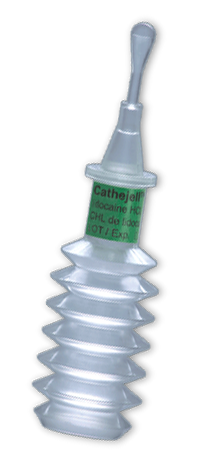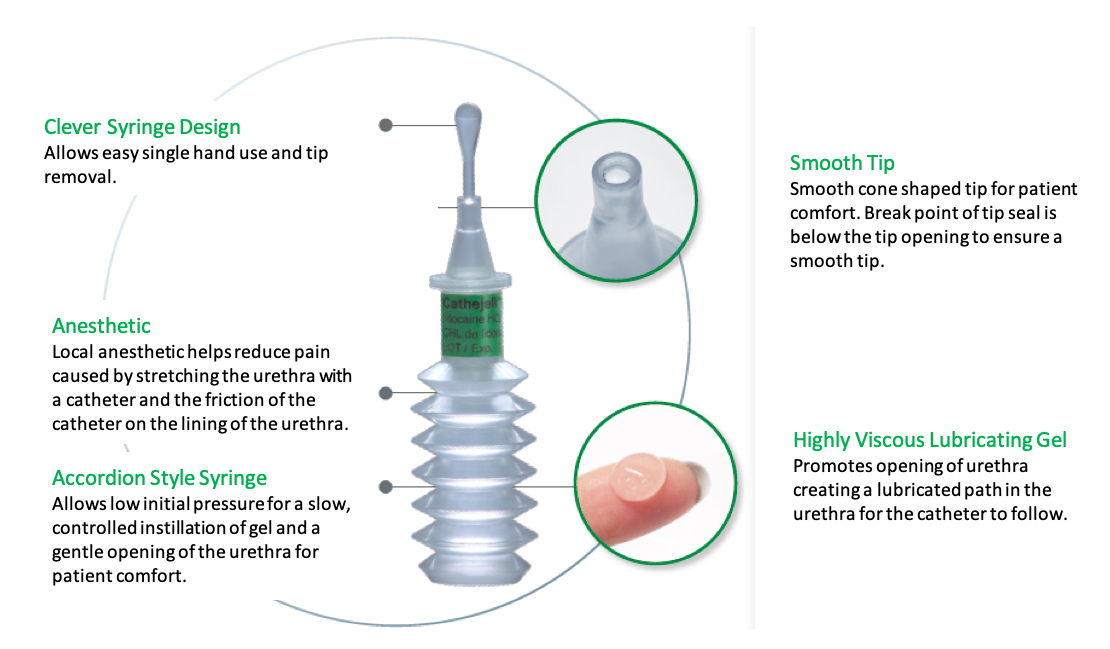Why Instill A Lubricant Into The Urethra Before Inserting a Catheter?
- The entire urethra is more evenly coated with lubricant to expand and open the urethra.
- The instillation of lubricant opens the urethra for the catheter, making it less likely to catch in the folds of the lining or in narrowed openings such as near the prostate in males.
- A more even coating of lubricant on the urethral lining can reduce the risk of damage to the urethra caused by catheter friction or contact of the catheter with the urethral folds in the lining. This cannot be done by coating the tip of a catheter before insertion in the urethra. This is because much of the lubricant is often pushed off the outside of the catheter as the catheter is pushed into the closed urethra.

Benefits Of Instillation With An Anesthetic Lubricating Gel
Individuals often experience pain or discomfort during catheterization. This is common during the early phases of learning to perform intermittent self-catheterization. It is important to have catheter lubrication along the entire length of the catheter to minimize the risk of pain and injury. In men, the correct positioning of the urethra can decrease pain and discomfort. Pain and discomfort usually decrease over time with increased experience.
The addition of an anesthetic to a urethral lubricating gel helps minimize pain caused by the stretching of the urethra and friction of the catheter on the lining of the urethra.1,2
Cathejell contains an anesthetic, 2% lidocaine hydrochloride, that allows for effective numbing of the lining of the urethra for prevention and control of pain when catheterizing the male and female urethra. Cathejell starts to work in three to five minutes with full numbing effect within five to 10 minutes after instillation into the urethra. It is possible to insert the catheter immediately after putting the lubricating gel in the urethra; however, if you do not wait the 5 minutes you may not get the full benefit of the anesthetic to numb the area and further reduce the risk of pain while inserting the catheter.
Cathejell®
Trusted by Doctors and Patients for 50 Years
Cathejell® Features & Benefits
Cathejell was designed to meet the needs of doctors and patients who wanted a product that was designed to be safe, easy to prepare and use, and more comfortable for the patient. For over 50 years Cathejell has delivered on that promise to doctors, nurses, and patients in hospitals and at home.
The unique accordion style syringe made it easier to control the rate of injecting gel into the urethra, making it more comfortable for the patient. That same design also allowed the convenience of opening the syringe and preparing it for use with the same hand, keeping it sterile.
Cathejell is a highly viscous, or thick, lubricant gel with an anesthetic, lidocaine, to reduce pain. By injecting a highly viscous lubricant gel directly into the urethra, it is possible to achieve a more even coating of lubricant on the lining of the urethra. The urethra is normally closed and is gently opened by the lubricating gel, which keeps the urethra open in front of the catheter. This provides an easy lubricated path for the catheter to follow to the bladder. This reduces the risk of pain and injury.

Cathejell Indications and Dosing
Cathejell Is Indicated For: Surface Anesthesia And Lubrication†
-
-
- For adult male and female urethra during catheterization, cystoscopy, exploration by sound, and other endourethral operations
- Nasal and pharyngeal cavities in endoscopic procedures such as gastroscopy and bronchoscopy
- Proctoscopy, rectoscopy
- Tracheal intubation
- Symptomatic treatment of pain in connection with cystitis and urethritis
-
Recommended Dose And Dosage Adjustment
| Dosage: Dose varies with area of application‡ | ||
|---|---|---|
| Usual Dosage | Maximum Dosage | |
| Adults | 5-20 g (½ – 2 syringes) |
40 g (4 syringes) |
| Children** | Varies as a function of age and weight | Up to 3 g/10 kg (⅓ syringe /10 kg) |
| No more than 40 g (4 syringes) in a 24-hour period for any age | ||
†Please refer to the Patient Information Leaflet
‡When fully compressed, each syringe expresses approximately 10 g of Cathejell® (9.4 mL, 200 mg lidocaine hydrochloride)
The amount expressed may vary with the technique used.
**Lidocaine should be used with caution in children younger than two years of age as there are insufficient data to support the safety and efficacy of this product in this patient population at this time.
This product may not be right for you. Always read and follow the label and consult your healthcare provider regularly to discuss whether this medicine is working for you and if it is causing you any unwanted effects.
References
-
-
- Tzortzis et al, Intraurethral Lubricants: A Critical Literature Review and Recommendations, Journal of Endurology, Vol 23, Number 5, May 2009 p 821-826
- Aygin D, Usta E, The effect of lubricants used in indwelling bladder catheterization through urethra on procedure-related pain: a literature review, Int J Clin Exp Med 2017;10(2):1995-2005, www.ijcem.com
-



 2476 Argentia Road, Suite 402
2476 Argentia Road, Suite 402 1.888.439.0013
1.888.439.0013 905.206.1413
905.206.1413 cathejell@biosyent.com
cathejell@biosyent.com